
Although an organisation’s IT infrastructure is typically built to handle large amounts of data, including that of video surveillance applications, many operators are not fully leveraging the functionalities of their investments to optimise bandwidth capacity. With a technologically advanced video management software (VMS), users can leverage existing hardware and software functionalities to experience benefits such as reduction in bandwidth requirements, optimisation of network resources, and decrease of storage needs.
Getting the most from your network resources
When it comes to IP video surveillance, it is important to efficiently manage the way video streams are transmitted over the network in order not to overload the available bandwidth. Even though IT infrastructures are built to handle any kind of data, the applications generating traffic over the IP network need to be conducive with the efficient utilisation of the network resources in place. To this end, different functionalities and mechanisms are offered by IP video surveillance solution providers to allow optimisation of bandwidth and network resources such as:
* Multicasting
* Multi-streaming
* Video compression
Even though the capacity and speed of the network are constantly increasing and its associated costs are declining, this is still not a good reason for users to ignore the additional investments and efforts needed to optimise bandwidth management. The amount of data travelling on the network is also still on the rise and therefore, investments in bandwidth optimisation are ones that can contribute to a reduction in total cost of ownership, specifically in respect to efficiency gains and maximised resources.
For example, in video surveillance, more and more end-users are requesting cameras with higher picture quality and resolution, often opting for high-definition and megapixel cameras. These types of cameras require much more bandwidth than standard definition cameras. Also, more and more people inside as well as outside an organisation’s walls are requesting access to video streams over the network. In the case where a large number of users are simultaneously trying to access a specific video stream, efficient use of network resources can be crucial in avoiding overloaded capacity and entire network crashes.
It is equally important to realise that optimising the bandwidth on the network does not necessarily go hand in hand with large capital investments, but is more a matter of putting the right solutions in place and leveraging the unique and powerful capabilities of these solutions. There are simple ways to optimise bandwidth management in IP video surveillance and three existing and proven methods will be discussed below.
Uncovering common methods of video stream transmission
There are essentially three ways of transmitting video streams over the network from the source to the destination: broadcast, unicast and multicast.
Broadcast
Broadcast is defined as a one-to-all communication between the source and the destinations. In IP video surveillance, the source refers usually to the IP camera and the destination refers to the monitoring station or the recording server. In this case, broadcasting would mean that the IP camera would send the video stream to all monitoring stations and recording servers, but also to any IP devices on the network, even though only a few specific destination sources had actually requested the stream. Typically, this method of transmission is not commonly used in IP video surveillance applications, but can be seen more often in the TV broadcasting industry where TV signals are switched at the destination level.
Unicast
Unicast is defined as a one-to-one communication between the source and the destination. Unicast transmissions are usually done in TCP or UDP and require a direct connection between the source and the destination. In this scenario, the IP camera (source) needs to have the capabilities to accept many concurrent connections when many destinations want to view or record that same video at the same time.
In terms of video streaming in unicast transmission, the IP camera will stream as many copies of the video feed requested by the destinations. In Figure 1, three copies of the same video stream are sent over the network; one copy for each of the three destinations requesting the stream. If each video stream is 4 Mbps, this transmission will produce 12 Mbps (3x4 Mbps) of data on multiple network segments.
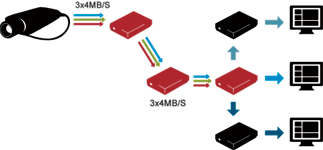
As a result, many destinations connected in unicast to a video source can result in high network traffic. In other words, if we imagine a large system with 200 destinations requesting the same video stream, we would end up having 800 Mbps (200x4 Mbps) of data travelling over the network, which is realistically unmanageable. Although this method of transmission is widely used over the Internet where most routers are not multicast-enabled, within a corporate LAN, unicast transmission is not necessarily the best practice as it can quickly increase the bandwidth needed for viewing and recording camera streams.
Multicast
In multicast transmission, there is no direct connection between the source and the destinations. The connection to the video stream of the IP camera is done by joining a multicast group, which in simple terms means actually connecting to the multicast IP address of the video stream. So the IP camera only sends a single copy of the video stream to its designated IP address and the destination simply connects to the stream available over the network with no additional overhead on the source. In other words, the destinations share the same video stream. In Figure 2, the same three destinations requesting the video stream have the same impact on the network as a single destination requesting the stream in unicast and there is no more than 4 Mbps of data travelling on each segment of the network. Even with 200 destinations requesting that video stream, the same amount of data would be travelling on the network.
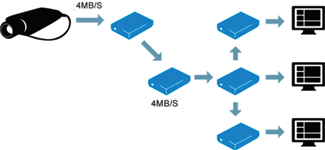
It is evident at this point that using multicast transmissions in an IP video surveillance application can save a lot of bandwidth, especially in large scale deployments where the number of destinations can grow very quickly.
Making multicast transmission worth your while
Multicast is a relatively simple method to improve bandwidth management. However, it must be supported by the following three components:
* Multicast-enabled routers and switches.
* IP video sources supporting multicast transmission.
* Back-end video system supporting multicast management.
In network terms, a switch supporting multicast can also be referred to as a switch supporting IGMP snooping or IGMP snooping and querying. IGMP snooping is a functionality that is usually handled by a Layer 2 switch. IGMP querying can be managed by the Layer 2 switch or by a multicast-enabled router. This equipment is the key component for building a multicast-capable network. A switch supporting IGMP snooping will ensure that the multicast traffic is only sent to the destinations that have requested the multicast stream and that it is filtered from the rest.
By simply sending messages such as 'IGMP join' or 'IGMP leave' on the network, destinations will or will not receive a multicast stream. To ensure that IGMP snooping is working correctly, at least one IGMP querier must be running on the network. The IGMP querier will ensure proper transmissions through the multicast connections.
Without these components, the multicast traffic will not be handled properly on the network causing unwanted traffic. A non multicast-enabled switch will in fact interpret the multicast packet as an unknown packet and transmit the packet of data to all destinations. Typically, IT departments are involved in providing a multicast-capable network and in ensuring that it has been properly configured.
In terms of IP video sources, most of the IP cameras and encoders on the market have support for multicast. An exception to that is some MJPEG IP video sources, as these types of sources essentially only stream in unicast. This limitation is not due to the compression format (MJPEG), but mainly occurs because MJPEG compression is usually coupled with HTTP for transmitting the stream, resulting in unicast streaming only. However, as RTSP is taking over the control of the stream, this will all soon change, allowing for MJPEG IP video sources to stream in multicast.
Now, having both a multicast network and a video unit streaming in multicast is still not entirely sufficient to effectively manage the multicast traffic over the network. The VMS that is being employed also needs to properly manage that multicast traffic. The main objective of this software is to provide the viewing client application and the recording server with the ability to join the multicast group over the network as described above. Of course, this is merely the minimum requirement for a VMS when it comes to facilitating the transmission of multicast video streams.
Taking multicast to new heights: intelligent video management software
In addition to this, the VMS must be much more intelligent to provide good control of the multicast traffic, and therefore should be able to conduct all the following:
* Managing multiple transmission methods within the same system.
* Offering a proxy service to transform unicast traffic to multicast, and vice versa.
* Providing auto-detection of the network capabilities.
The reason why a video management system needs to support multiple transmission methods is because networks are complex and IP video sources do not all transmit identically. Segments of a network do not all necessarily support multicast. For example, in a video surveillance system, some IP cameras could be located on the corporate LAN and others could be mounted outside where they transmit data over a wireless network without multicast support. In addition to this, in this same video surveillance system, even if most of the viewing stations are located in the corporate LAN with multicast support, some of them could be connecting to the system via the Internet, as illustrated in Figure 3.
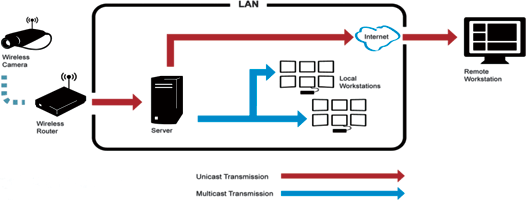
In this scenario, an intelligent video management system can handle recording from multicast- and unicast-enabled cameras, transform the unicast cameras into multicast cameras to ensure efficient bandwidth utilisation for local users, and provide a unicast stream to the remote clients, all while using a single server.
This server, acting as a proxy, is another very important component in efficiently managing the video traffic over the network. Ideally, this server must be able to auto-detect the connection type of the camera or the viewing client. This way, if a user sometimes connects from the corporate LAN, and then other times connects remotely from home, where multicast video transmission is not available, the video management server will have the ability to detect the point of connection, and automatically provide the viewing client with the most optimal type of stream.
Also, another important functionality of the video management system is the capability to transform a unicast-only camera into a multicast camera. This is important not only for cameras streaming over wireless links, but also for MJPEG cameras as described earlier. Usually, this is done by the video management server that is capable of getting the unicast stream from the camera and creating a multicast stream for the clients.
Getting more with multi-streaming capabilities
In IP video surveillance, multi-streaming is defined as the capability for an IP video source to produce multiple video streams of the same camera at different video quality. For example, an IP camera could produce one video stream at 4CIF 30 fps and another video stream at CIF 10 fps. However, once again, an IP video source capable of producing multiple streams is not enough to get multi-streaming support. The back-end VMS must be able to control those streams as well.
Purpose-based multi-streaming
To that effect, a sophisticated video management system will offer the system administrator the possibility to easily and effectively configure the available video streams for different purposes, such as live viewing, live remote viewing (with reduced bandwidth), recording, or any other specific purpose.
A typical way of configuring a system would be to setup a stream for live viewing at CIF 30 fps for maximum fluidity and a second stream for recording at CIF 10 fps to save on the bandwidth, allowing all cameras to be recorded at the same time while a few cameras are being monitored in real-time. Of course, in addition to bandwidth reduction, using a second stream for recording will also bring savings in terms of storage.
More so, multi-streaming is not limited to differentiating quality between live and recorded video streams as it can be used for many other purposes. For example, people could use it to record two different streams at different qualities for short (higher quality) and long (lower quality) term storage. The positive impact of this configuration on the bandwidth consumption is obvious when it comes to transferring the recorded video to a long-term storage medium. Recording two different streams does not require transferring the video from one place to the other.
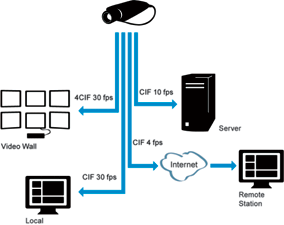
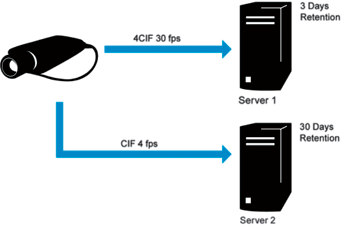
Multi-streaming for remote user access
Multi-streaming can also be used to set up a lower quality stream for remote users and still keep a high-resolution stream for local viewing and recording. This is often necessary when the administrator of the video management system does not have the control over the capacity of the external network. Therefore, utilising a stream that requires low bandwidth can ensure that remote users always have access to the video, wherever they are.
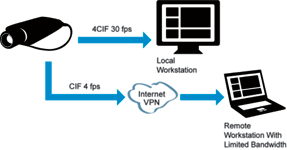
Multi-streaming for maximised tile viewing
Another useful application for multi-streaming is the ability to access the different streams directly from the operator screen. For example, sometimes operators like to view up to 16 cameras on the same monitor. If the streams are configured at 4CIF 30fps at around 4 Mbps, it will consume 64 Mbps of bandwidth as the data transmits to the client station. The size of the viewing tiles in a 16-camera layout on a 20-inch monitor might not require a 4CIF resolution quality, and therefore having the ability to switch to a lower resolution stream, CIF for example, will have a direct impact on the required bandwidth, without affecting the viewing quality. See Figure 7.

Managing video compression formats for optimal network load
The last point to discuss about bandwidth management is the ability for a video management system to support multiple compression formats that are available from the IP video sources. The most common video compression formats in IP video surveillance are: H.264, MPEG-4, MJPEG, MPEG-2, Wavelet and JPEG2000, and each of these compression formats have their own pros and cons. The decision of selecting one compression format over another is based on multiple factors such as:
* Latency.
* Image quality.
* Storage requirement.
* Number of cameras.
* Bandwidth consumption.
MPEG-4 and its successor, H.264, are the most efficient compression formats available today in terms of bandwidth utilisation. These compression formats are usually the best choice when it comes to bandwidth and storage savings without compromising video quality, as opposed to MJPEG which can offer a great picture quality but has a big impact on the bandwidth. MJPEG can still be a good compression format especially when it is used at a low bitrate on slow links because each frame is independent. So, unlike H.264 and MPEG-4, if one frame is lost in MJPEG, it is not a whole sequence of frames that will be lost, but really only a single frame. On the other hand, if we look at Figure 8, with the same level of video quality, we can clearly see the variation between different compression formats (H.264, MPEG-4 and MJPEG). With approximately one-sixth of the bandwidth utilisation used by H.264 over MJPEG, H.264 is clearly the best choice when it comes to bandwidth and storage optimisation.
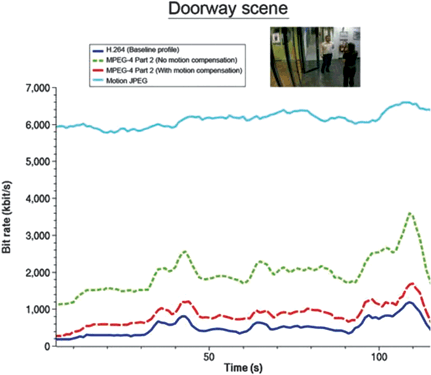
Now, since IP video surveillance is living the same evolution as TV broadcasting is with HDTV, IP video sources also offer higher resolutions with network throughput-intensive megapixel cameras, and thus H.264 will be the standard compression format in the industry due to its low bandwidth utilisation. This is why is it important to look for a somewhat future-proofed VMS that supports the advanced technologies of today and tomorrow.
Making it all come together: the video management software
Multicasting, multi-streaming and video compression are three of many ways to optimise bandwidth utilisation in IP video surveillance applications. The edge devices or IP video sources are becoming more and more intelligent, providing some of the functionalities that were initially only provided at the head-end level by the video surveillance platform. For example, some IP video sources are able to perform video analysis directly at the edge and only stream the video upon alarms. Even better, some IP video sources can store the video directly at the edge and act as mini-recording units.
Nevertheless, all of these intelligent functionalities absolutely need to be brought forth by the video surveillance platform for users to truly take advantage of all their related benefits. With a strong and innovative VMS, users will be able to fully leverage the latest advancements in technology, directly contributing to a reduction in bandwidth requirements, an optimisation of network resources, and a decrease of storage needs. Ultimately, an advanced VMS will help users to effectively cut back significant costs and help to keep their investments future-proof as newer technologies emerge.
Is your video management software helping you optimise bandwidth management?
As you’ve read in the previous pages, an intelligent VMS is a necessity to support the various methods that contribute to bandwidth optimisation in a video surveillance application. Through innovative features and sophisticated technology, a VMS will help you leverage specific functionalities such as multicasting, multi-streaming and video compression in order to optimise network resources, reduce storage requirements, and ultimately lower your total cost of ownership.
That is why it is important to take a moment to see if you have the right VMS in place to truly optimise your bandwidth management.
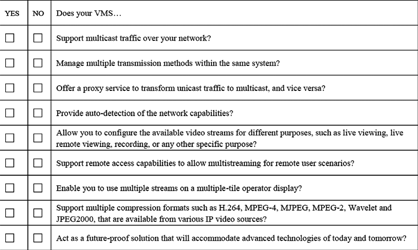
References
Axis Communications. White Paper - H.264 Video Compression Standard. Retrieved February 25, 2009 from Axis Communications Online: http://www.axis.com/files/whitepaper/wp_videocompression_33085_en_0809_lo.pdf
Axis Communications. White Paper - An Explanation of Video Compression Techniques. Retrieved February 25, 2009 from Axis Communications Online: http://www.axis.com/files/whitepaper/wp_videocompression_33085_en_0809_lo.pdf
CISCO. White Paper - Overview of IP Multicast. Retrieved February 27, 2009 from Cisco Online: http://www.cisco.com/en/US/tech/tk828/technologies_white_paper09186a0080092942.shtml
Sony Professional Solutions Europe. Video Compression Technology - H.264 Explained. Retrieved February 27, 2009 from SourceSecurity.com: http://www.sourcesecurity.com/news/articles/co-3289-ga.2806.html
Tanenbaum, Andrew S. (2003). Computer Networks, 4th Edition. New Jersey: Pearson Education Ltd.
Wikipedia. Multicast. Retrieved March 15, 2009 from Wikipedia Online: http://en.wikipedia.org/wiki/Multicast
Wikipedia. Streaming Media. Retrieved March 15, 2009 from Wikipedia Online: http://en.wikipedia.org/wiki/Streaming_media
Wikipedia. IGMP Snooping. Retrieved March 15, 2009 from Wikipedia Online: http://en.wikipedia.org/wiki/IGMP_snooping
Source: Genetec. Used with permission. This paper is available at http://www.genetec.com/Documents/EN/Whitepapers/EN-Genetec-Three-Simple-Ways-to-Optimize-Your-Bandwidth-Management-in-Video-Surveillance-WhitePaper.pdf
For more information on how your VMS can help you get the most out of bandwidth optimisation, contact Etienne Bruwer, +27 (0)21 979 3007, etienne.bruwer@inmarsat.com; or a Genetec representative at +1 866 684 8006 or marketing@genetec.com

© Technews Publishing (Pty) Ltd. | All Rights Reserved.